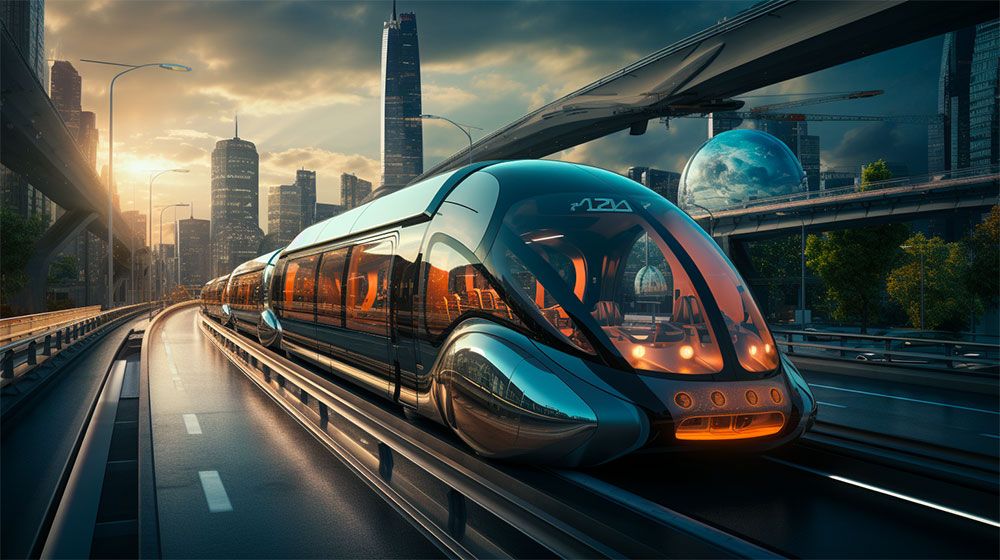Urban transportation innovations are reshaping how we get around—think app-integrated MaaS platforms, on‑demand shuttles, electric air taxis, and robotaxis. These high‑impact trends promise smarter, greener, and faster city travel.

1. Air Taxis Enter the Skyline: eVTOLs Get Real
Silicon Valley and global cities are racing to bring electric vertical take-off and landing (eVTOL) vehicles into everyday use. Companies like Archer Aviation and Joby Aviation are developing air taxi systems to shuttle commuters between dense hubs—such as across Napa or from Palo Alto to Tahoe—offering Uber‑like pricing but dramatically faster travel . Joby even completed a successful 12‑minute test flight, while Archer is building “vertiports” for takeoffs and landings. Meanwhile, helicopter‑based commuter services like Blade now offer 95 dollars rides from Long Island and New Jersey to Manhattan.
While challenges around FAA certification, urban landing zones, airspace regulation, and costs remain, the shift to aerial commuting symbolizes just how expansive urban transportation innovations are becoming—even as far as the skies.
2. MaaS Platforms: Seamless Travel in One App
Mobility as a Service (MaaS) is evolving from concept to reality. These platforms unify buses, metros, ride‑share, e‑scooters, and more under a single digital interface for planning, paying, and riding. CUMTA in Chennai, India, is rolling out a unified ticketing and trip‑planning app that combines metro, buses, cabs, and autos with future integration of suburban trains—making it India’s first MaaS initiative of its kind.
The MaaS market is growing fast: valued at USD 421.9 billion in 2024, it’s projected to reach over USD 1.43 trillion by 2032, with Asia-Pacific leading rapid growth. Startups and governments are teaming up for similar solutions globally, using smart-city frameworks to drive adoption.
3. Microtransit & On‑Demand Shuttles: Closing Gaps
Microtransit—flexible, demand-responsive shuttles—are proliferating in urban zones where traditional transit struggles. San Diego’s “Southeastern Connect” offers on-demand shuttles to underserved neighborhoods like Chollas View and Emerald Hills, funded through a 3.8M dollars pilot program. VIA Metro in San Antonio blends bus reliability with ride-sharing convenience in its VIA Link service, offering app-booking, free bus transfers, and affordable ride.
Across Europe, Deutsche Bahn’s ioki is rolling out shuttle fleets and remote‑driving tech to streamline public transportation—even enabling remote‑driven service. These projects illustrate how urban transportation innovations are aiming to be both flexible and inclusive.
4. Autonomous Vehicle Boom: Robotaxis & Beyond
Self-driving vehicles are accelerating faster than ever. Uber has partnered with May Mobility to deploy autonomous minivans in U.S. cities—beginning in Arlington, Texas—via its ride-hailing app. May Mobility also revealed the Technobus, a 30‑seat autonomous electric bus deploying modular batteries, with testing slated in Europe, Canada, and the U.S. by late 2026.
Meanwhile, WeRide is expanding globally: operating fare-charging autonomous buses in Guangzhou and launching robotaxi testing across the Middle East—including Abu Dhabi, Saudi Arabia, and more—with support from Uber and Tencent Cloud.
Waze co-founder Uri Levine forecasts that the next generation may stop driving altogether— with robotaxis dropping ride prices from 100 dollars to as low as 25 dollars and transforming both transit and retail landscapes.
5. AI, Digital Twins & Smart Infrastructure
Cities are increasingly leaning on AI and virtual models to optimize transit. Digital twin technology—creating real-time urban transport simulations—helps authorities predict traffic patterns and test solutions without disruptions. Forbes highlights that digital twins and AI-driven urban mobility are becoming common tools for managing congestion and optimizing curb usage.
Furthermore, AI is being deployed across transportation fleet management, dynamic traffic controls, adaptive EV charging stations, and micromobility regulation. Together, these tools enable cities to become more resilient and dynamically responsive to evolving commuter behaviors.
6. Electric Vehicles and Micromobility for Green Moves
Electrified mobility is accelerating. Shared micromobility platforms—e-scooters, e-bikes, cargo bikes—are becoming staples. Over 420 U.S. cities now host shared micromobility programs, accounting for billions of rides and a majority using electric devices . Transportation planners cite these as “one of the most exciting trends,” particularly when integrated into transit networks for first/last‑mile connectivity .
In India, Yulu offers dockless, low-speed EVs across multiple cities. With over 45,000 vehicles and four million users, Yulu has generated 100M+ rides, reduced CO₂ by 32M kg, and offered 240M+ green deliveries—proving micromobility’s scale and impact . These urban transportation innovations are key strategies in reducing congestion and emissions while improving affordability.
7. Global City Planners: Dubai’s Integrated Vision
Internationally, Dubai is setting benchmarks for integrated, future-forward mobility. The city plans to deploy autonomous taxis by 2026 via Pony.ai, with aspirations for 25% of all transport automated by 2030. It’s also transitioning to hybrid or full-electric taxi fleets by 2027 and launching flying taxi services in collaboration with Joby Aviation and Volocopter .
Dubai’s model illustrates how generous policy, cross-sector partnerships, and infrastructure synergy can fast-forward urban transportation innovations.
Why These Trends Matter
- Efficiency Redefined: Air taxis, robotaxis, MaaS, and microtransit reduce wait times, cut travel durations, and optimize route planning.
- Green Gains: Electrification, micromobility, and digital transforms support sustainable urban ecosystems.
- Inclusion & Flexibility: On-demand, app-based transit bridges service gaps in underserved neighborhoods.
- Tech-Driven Resilience: AI and digital twins let planners test, predict, and respond dynamically to city needs.
- Next-Generation Norms: Young generations may never need or drive personal cars, reshaping vehicle ownership and urban design.
What Lies Ahead: 5 Key Strategic Shifts
- Integrated City Systems: Cross-modal, digital-first frameworks (air-ground, app routes, shared systems) will be essential.
- Regulatory Alignment: eVTOL permits, AV safety rules, data governance, and urban airspace will need coherent policies.
- Investment & Equity: Scaling requires sustained public-private investment, and ensuring underserved areas are served fairly.
- Public Trust & Data Transparency: Acceptance hinges on safe, reliable service and clear use of commuter data.
- Climate-Centric Growth: Innovations must prioritize low-carbon operation—electrification, renewables, and sustainable infrastructure.
Final Thoughts
Emerging urban transportation innovations are not futuristic dreams—they’re unfolding now. From the skies above via air taxis to digital MaaS systems, autonomous vehicles, micromobility, and AI‑enhanced infrastructure—cities are transforming. Incorporating these trends into planning and policy will be key to building urban travel that is faster, cleaner, and more accessible than ever.
Let me know if you’d like an article adapting this to a specific region, an in-depth guide to MaaS deployment, or a breakdown of regulatory strategies for autonomous transit.
References
- San Francisco Chronicle. (2025, May 15). Want to take an air taxi to Tahoe? The option could be here sooner than you think. Available at: https://www.sfchronicle.com (Accessed: 20 August 2025).
- Times of India. (2025, March 5). CUMTA to roll out app to integrate metro, bus, last-mile connectivity.
Available at: https://timesofindia.indiatimes.com (Accessed: 20 August 2025). - Axios. (2025, August 18). San Diego hopes microtransit can patch its transportation system.
Available at: https://www.axios.com (Accessed: 20 August 2025).









